The Use of Waste Tyre Rubber Recycled Products in Lightweight Timber Frame Systems as Acoustic Insulation: A Comparative Analysis of Acoustic Performance
Abstract
:1. Introduction
2. A Brief Overview of Different Aspects Affecting the Ecological Impact of Construction Materials and Their Corresponding Thermal and Acoustic Performance
2.1. Recycled Materials in Construction
2.2. Wood: A Sustainable Material in Building Constructions
2.2.1. Wood as a 100% Sustainable Material and a CO2 Container
2.2.2. Timber Construction: Timber Frame and CLT
2.2.3. Sound Insulation in Timber Construction
2.3. Insulation in Construction: Energy Savings and Sound Insulation
2.3.1. Currently Used Materials for Improved Thermal and Acoustic Performance in Buildings
2.3.2. New Recycled Materials for Improved Thermal and Acoustic Performance in Buildings
2.4. GTR as a Recycled Material in Building Construction
2.4.1. General Civil and Building Construction Uses
2.4.2. New Uses as Sound Insulation
2.4.3. New Uses as Thermal Insulation
2.5. Performance Evaluation in Building Acoustics
3. Materials and Methods
3.1. Small-Size Acoustic Box
3.2. Laboratory Tests: Standardized Comparative Tests
3.3. Materials’ and Samples’ Description
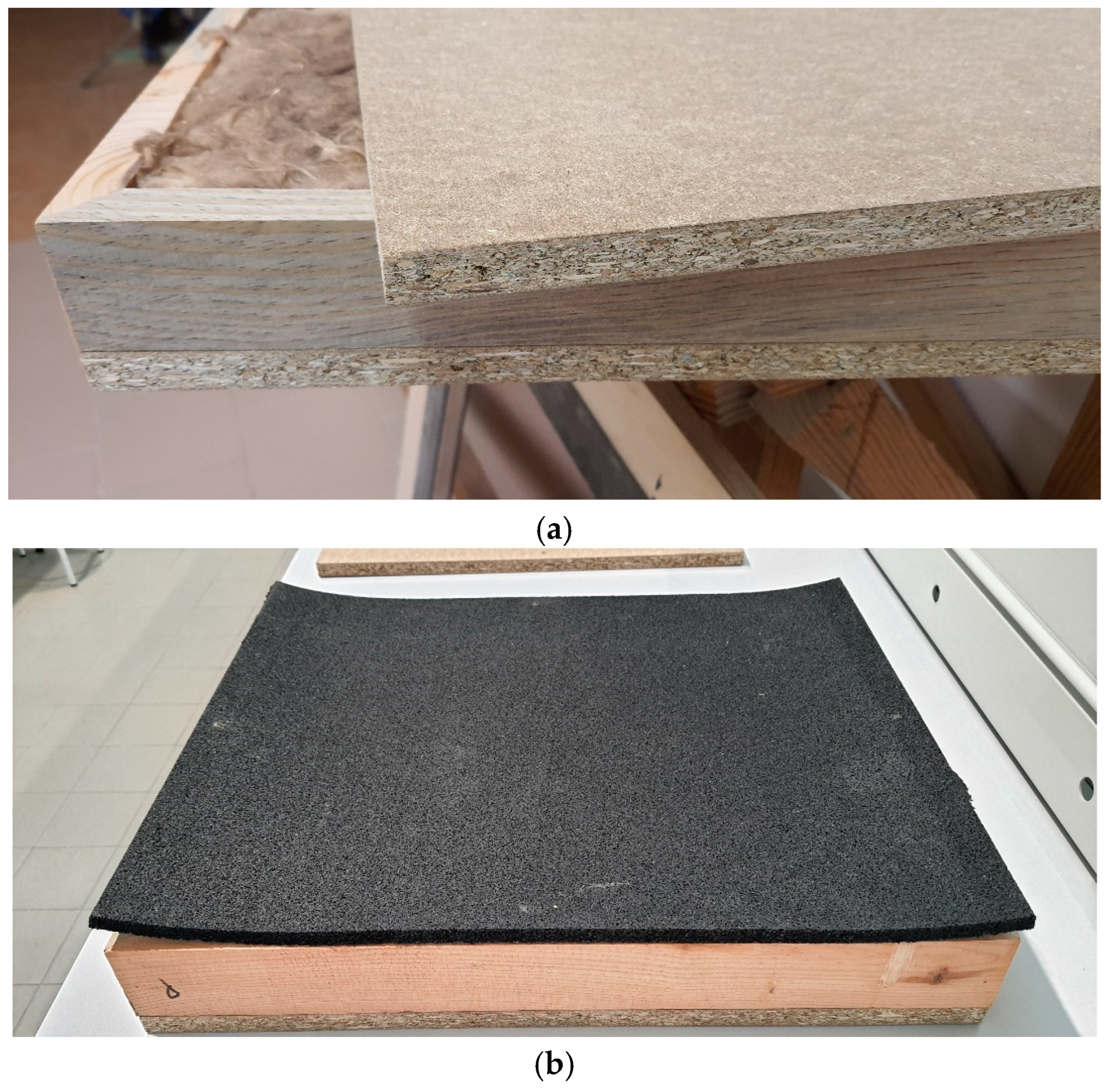

4. Results and Discussion
4.1. Custom Acoustic Box


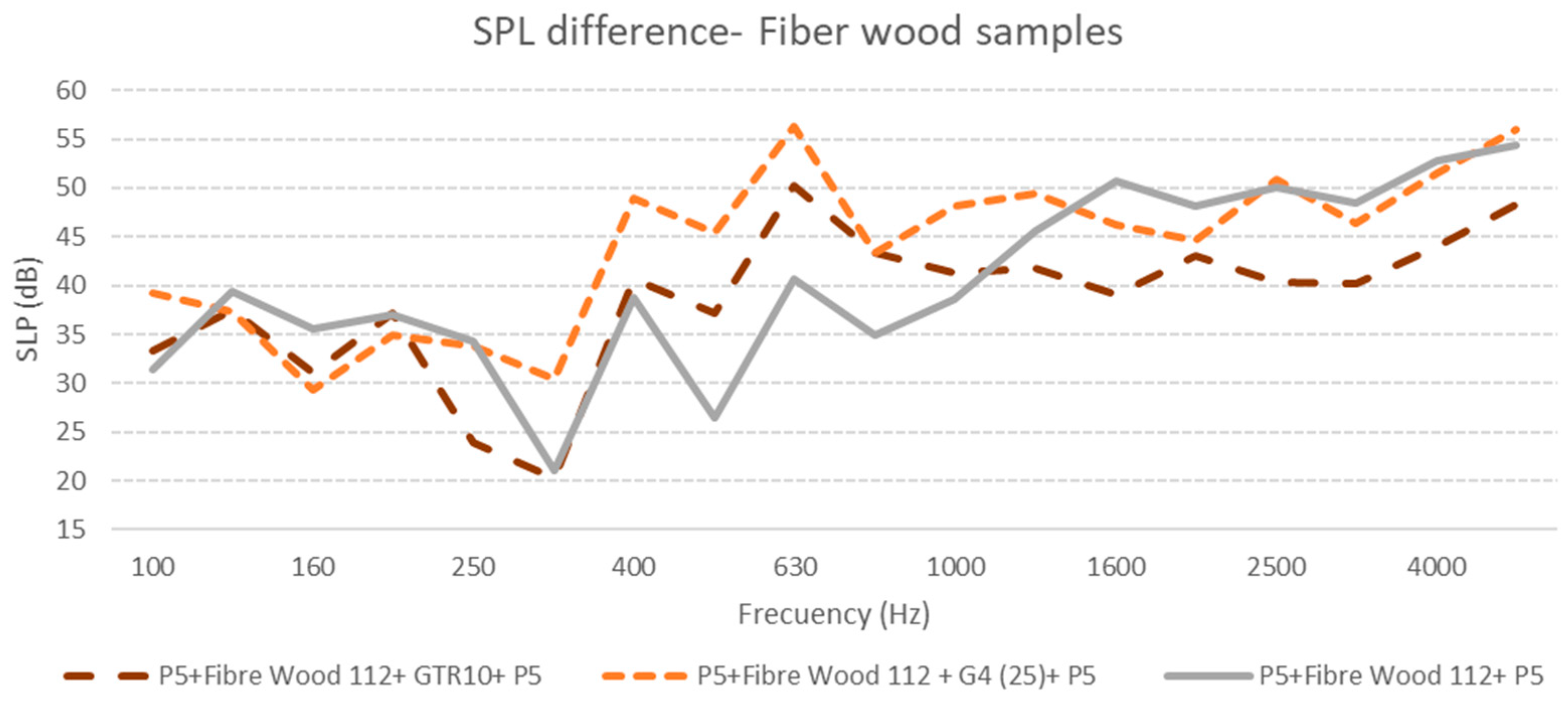
4.2. Laboratory Tests
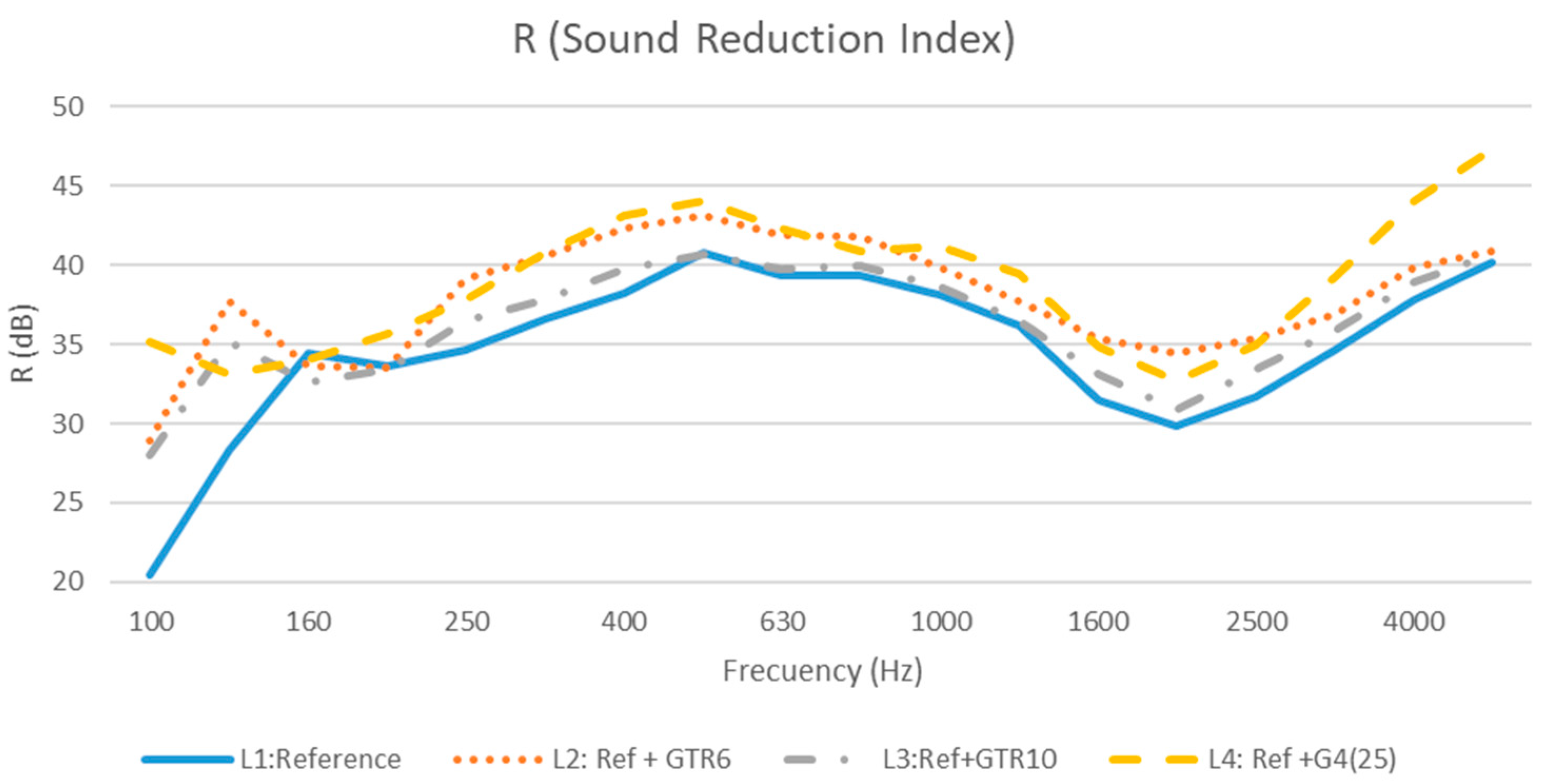
| L1 (Reference) | L2 (L1 + GTR6) | L3 (L1 + GTR10) | L4 (L1 + G4(25)) | ||
|---|---|---|---|---|---|
| Rw (C;Ctr) | dB | 35 (−2;1) | 38 (−1;0) | 36 (−1;0) | 38 (−1;0) |
| R(A) | dBA | 34.1 | 37.4 | 35.3 | 37.6 |
| R(Atr) | dBA | 33.6 | 37.5 | 35.5 | 37.7 |
5. Conclusions
Author Contributions
Funding
Data Availability Statement
Acknowledgments
Conflicts of Interest
References
- Helmers, E.; Dietz, J.; Hartard, S. Electric car life cycle assessment based on real-world mileage and the electric conversion scenario. Int. J. Life Cycle Assess. 2017, 22, 15–30. [Google Scholar] [CrossRef]
- BloombergNEF. Energy Transition Investment Trends 2021; Tracking Global Investment in the Low-Carbon Energy Transition; Technical Report; BloombergNEF: London, UK, 2022. [Google Scholar]
- Pipitone, E.; Caltabellotta, S.; Occhipinti, L. A Life Cycle Environmental Impact Comparison between Traditional, Hybrid, and Electric Vehicles in the European Context. Sustainability 2021, 13, 10992. [Google Scholar] [CrossRef]
- Presti, D.L. Recycled Tyre Rubber Modified Bitumens for road asphalt mixtures: A literature review. Constr. Build. Mater. 2013, 49, 863–881. [Google Scholar] [CrossRef]
- Moasas, A.M.; Amin, M.N.; Khan, K.; Ahmad, W.; Al-Hashem, M.N.A.; Deifalla, A.F.; Ahmad, A. A worldwide development in the accumulation of waste tires and its utilization in concrete as a sustainable construction material: A review. Case Stud. Constr. Mater. 2022, 17, e01677. [Google Scholar] [CrossRef]
- Martin, F. Recycling and Re-Use of Waste Rubber; Smitthers: Shawbury, UK, 2014. [Google Scholar]
- Valentini, F.; Pegoretti, A. End-of-life options of tyres. Rev. Adv. Ind. Eng. Polym. Res. 2022, 5, 203–213. [Google Scholar] [CrossRef]
- Mohajerani, A.; Burnett, L.; Smith, J.V.; Markovski, S.; Rodwell, G.; Rahman, M.T.; Kurmus, H.; Mirzababaei, M.; Arulrajah, A.; Horpibulsuk, S.; et al. Recycling waste rubber tyres in construction materials and associated environmental considerations: A review. Resour. Conserv. Recycl. 2020, 155, 104679. [Google Scholar] [CrossRef]
- Downard, J.; Singh, A.; Bullard, R.; Jayarathne, T.; Rathnayake, C.M.; Simmons, D.L.; Wels, B.R.; Spak, S.N.; Peters, T.; Beardsley, D.; et al. Uncontrolled combustion of shredded tires in a landfill—Part 1: Characterization of gaseous and particulate emissions. Atmos. Environ. 2015, 104, 195–204. [Google Scholar] [CrossRef]
- Nuzaimah, M.; Sapuan, S.M.; Nadlene, R.; Jawaid, M. Recycling of waste rubber as fillers: A review. IOP Conf. Ser. Mater. Sci. Eng. 2018, 368, 012016. [Google Scholar] [CrossRef]
- Thomas, B.S.; Gupta, R.C. A comprehensive review on the applications of waste tire rubber in cement concrete. Renew. Sustain. Energy Rev. 2016, 54, 1323–1333. [Google Scholar] [CrossRef]
- Medina, N.F.; Garcia, R.; Hajirasouliha, I.; Pilakoutas, K.; Guadagnini, M.; Raffoul, S. Composites with recycled rubber aggregates: Properties and opportunities in construction. Constr. Build. Mater. 2018, 188, 884–897. [Google Scholar] [CrossRef]
- Bala, A.; Gupta, S. Thermal resistivity, sound absorption and vibration damping of concrete composite doped with waste tire Rubber: A review. Constr. Build. Mater. 2021, 299, 123939. [Google Scholar] [CrossRef]
- Al-Bared, M.A.M.; Marto, A.; Latifi, N. Utilization of Recycled Tiles and Tyres in Stabilization of Soils and Production of Construction Materials—A State-of-the-Art Review. KSCE J. Civ. Eng. 2018, 22, 3860–3874. [Google Scholar] [CrossRef]
- Council, C.W. Life cycle analysis for residential buildings. Wood Renew Resour. Bull. 1999, 5, 124–136. [Google Scholar]
- European Union. Decision No 1386/2013/EU of the European Parliament and of the Council of 20 November 2013 on a General Union Environment Action Programme to 2020 ‘Living Well, within the Limits of Our Planet’; European Union: Brussels, Belgium, 2013; pp. 171–200. [Google Scholar]
- D’Alessandro, F.; Schiavoni, S. A review and comparative analysis of European priority indices for noise action plans. Sci. Total Environ. 2015, 518–519, 290–301. [Google Scholar] [CrossRef]
- Directorate-General for Environment. Resource Efficient Use of Mixed Wastes. Improving Management of Construction and Demolition Waste; European Commission: Luxembourg, Belgium, 2017.
- European Union. DIRECTIVE 2008/98/EC of the European Parliament and of the Council; European Union: Brussels, Belgium, 2002. [Google Scholar]
- European Union. DIRECTIVE (EU) 2018/851 of the European Parliament and of the Council of 30 May 2018 Amending Directive 2008/98/EC on Waste; European Union: Brussels, Belgium, 2018. [Google Scholar]
- Cardoso, R.; Silva, R.V.; de Brito, J.; Dhir, R. Use of recycled aggregates from construction and demolition waste in geotechnical applications: A literature review. Waste Manag. 2016, 49, 131–145. [Google Scholar] [CrossRef]
- Pourkhorshidi, S.; Sangiorgi, C.; Torreggiani, D.; Tassinari, P. Using Recycled Aggregates from Construction and Demolition Waste in Unbound Layers of Pavements. Sustainability 2020, 12, 9386. [Google Scholar] [CrossRef]
- Bohringer, C.; Vogt, C. Economic and environmental impacts of the Kyoto Protocol. Can. J. Econ. Can. Econ. 2003, 36, 475–496. [Google Scholar] [CrossRef]
- Mandley, S.; Wicke, B.; Junginger, H.; van Vuuren, D.; Daioglou, V. Integrated assessment of the role of bioenergy within the EU energy transition targets to 2050. GCB Bioenergy 2022, 14, 157–172. [Google Scholar] [CrossRef]
- Bucking, S.; Rostami, M.; Reinhart, J.; St-Jacques, M. On modelling of resiliency events using building performance simulation: A multi-objective approach. J. Build. Perform. Simul. 2022, 15, 307–322. [Google Scholar] [CrossRef]
- Favero, A.; Mendelsohn, R.; Sohngen, B. Using forests for climate mitigation: Sequester carbon or produce woody biomass? Clim. Chang. 2017, 144, 195–206. [Google Scholar] [CrossRef]
- Ceccherini, G.; Duveiller, G.; Grassi, G.; Lemoine, G.; Avitabile, V.; Pilli, R.; Cescatti, A. Abrupt increase in harvested forest area over Europe after 2015. Nature 2020, 583, 72–77. [Google Scholar] [CrossRef]
- Peichl, M.; Arain, A.M.; Moore, T.R.; Brodeur, J.J.; Khomik, M.; Ullah, S.; Restrepo-Coupé, N.; McLaren, J.; Pejam, M.R. Carbon and greenhouse gas balances in an age sequence of temperate pine plantations. Biogeosciences 2014, 11, 5399–5410. [Google Scholar] [CrossRef]
- Singh, T.; Arpanaei, A.; Elustondo, D.; Wang, Y.; Stocchero, A.; West, T.A.P.; Fu, Q. Emerging technologies for the development of wood products towards extended carbon storage and CO2 capture. Carbon Capture Sci. Technol. 2022, 4, 100057. [Google Scholar] [CrossRef]
- Dixon, R.K.; Solomon, A.M.; Brown, S.; Houghton, R.A.; Trexier, M.C.; Wisniewski, J. Carbon Pools and Flux of Global Forest Ecosystems. Science 1994, 263, 185–190. [Google Scholar] [CrossRef]
- Geng, A.; Yang, H.; Chen, J.; Hong, Y. Review of carbon storage function of harvested wood products and the potential of wood substitution in greenhouse gas mitigation. For. Policy Econ. 2017, 85, 192–200. [Google Scholar] [CrossRef]
- Hoxha, E.; Passer, A.; Saade, M.R.M.; Trigaux, D.; Shuttleworth, A.; Pittau, F.; Allacker, K.; Habert, G. Biogenic carbon in buildings: A critical overview of LCA methods. Build. Cities 2020, 1, 504–524. [Google Scholar] [CrossRef]
- Kayo, C.; Noda, R.; Sasaki, T.; Takaoku, S. Carbon balance in the life cycle of wood: Targeting a timber check dam. J. Wood Sci. 2015, 61, 70–80. [Google Scholar] [CrossRef]
- Chen, L.; Huang, L.; Hua, J.; Chen, Z.; Wei, L.; Osman, A.I.; Fawzy, S.; Rooney, D.W.; Dong, L.; Yap, P.-S. Green construction for low-carbon cities: A review. Environ. Chem. Lett. 2023, 21, 1627–1657. [Google Scholar] [CrossRef]
- Hill, C.A.S.; Dibdiakova, J. The environmental impact of wood compared to other building materials. Int. Wood Prod. J. 2016, 7, 215–219. [Google Scholar] [CrossRef]
- Harris, D.J. A quantitative approach to the assessment of the environmental impact of building materials. Build. Environ. 1999, 34, 751–758. [Google Scholar] [CrossRef]
- Risse, M.; Weber-Blaschke, G.; Richter, K. Eco-efficiency analysis of recycling recovered solid wood from construction into laminated timber products. Sci. Total Environ. 2019, 661, 107–119. [Google Scholar] [CrossRef]
- Risse, M.; Richter, K. CaReWood—Cascading Recovered Wood Teilvorhaben: Ökologische und Ökonomische Bewertung der Kaskadischen Holznutzung; Technical University of Munich: Munich, Germany, 2018. [Google Scholar]
- Sandberg, K.; Sandin, Y.; Harte, A.; Shotton, E. Summary Report InFutUReWood—Innovative Design for the Future—Use and Reuse of Wood (Building) Components; DiVA, Uppsala University: Uppsala, Sweden, 2022. [Google Scholar]
- Balmori, J.-A.; Basterra, L.-A.; Acuña, L. Internal GFRP Reinforcement of Low-Grade Maritime Pine Duo Timber Beams. Materials 2020, 13, 571. [Google Scholar] [CrossRef]
- Szichta, P.; Risse, M.; Weber-Blaschke, G.; Richter, K. Potentials for wood cascading: A model for the prediction of the recovery of timber in Germany. Resour. Conserv. Recycl. 2022, 178, 106101. [Google Scholar] [CrossRef]
- Hafner, A.; Ott, S.; Winter, S. Recycling and End-of-Life Scenarios for Timber Structures. In Materials and Joints in Timber Structures: Recent Developments of Technology; Springer Netherlands: Dordrecht, The Netherlands, 2014; pp. 89–98. [Google Scholar]
- Llana, D.F.; González-Alegre, V.; Portela, M.; Íñiguez-González, G. Cross Laminated Timber (CLT) manufactured with European oak recovered from demolition: Structural properties and non-destructive evaluation. Constr. Build. Mater. 2022, 339, 127635. [Google Scholar] [CrossRef]
- Giordano, L.; Derikvand, M.; Fink, G. Bending Properties and Vibration Characteristics of Dowel-Laminated Timber Panels Made with Short Salvaged Timber Elements. Buildings 2023, 13, 199. [Google Scholar] [CrossRef]
- Risse, M.; Weber-Blaschke, G.; Richter, K. Resource efficiency of multifunctional wood cascade chains using LCA and exergy analysis, exemplified by a case study for Germany. Resour. Conserv. Recycl. 2017, 126, 141–152. [Google Scholar] [CrossRef]
- Sirkin, T.; ten Houten, M. The cascade chain: A theory and tool for achieving resource sustainability with applications for product design. Resour. Conserv. Recycl. 1994, 10, 213–276. [Google Scholar] [CrossRef]
- Švajlenka, J.; Kozlovská, M. Evaluation of the efficiency and sustainability of timber-based construction. J. Clean. Prod. 2020, 259, 120835. [Google Scholar] [CrossRef]
- Mettem, C.J.; Bainbridge, R.J.; Pitts, G.C.; Enjily, V. Timber frame construction for medium-rise buildings. Prog. Struct. Eng. Mater. 1998, 1, 253–262. [Google Scholar] [CrossRef]
- Brandner, R.; Flatscher, G.; Ringhofer, A.; Schickhofer, G.; Thiel, A. Cross laminated timber (CLT): Overview and development. Eur. J. Wood Wood Prod. 2016, 74, 331–351. [Google Scholar] [CrossRef]
- Harte, A.M. Mass timber—The emergence of a modern construction material. J. Struct. Integr. Maint. 2017, 2, 121–132. [Google Scholar] [CrossRef]
- Kretschmann, D.E. mechanical properties of wood. In Wood Handbook; Forest Products Laboratory, Department of Agriculture Forest Service: Madison, WI, USA, 2010. [Google Scholar]
- Caniato, M.; Marzi, A.; da Silva, S.M.; Gasparella, A. A review of the thermal and acoustic properties of materials for timber building construction. J. Build. Eng. 2021, 43, 103066. [Google Scholar] [CrossRef]
- Vasseur, E. United Nations Conference on the Human Environment: Stockholm, 5–16 June 1972. Water Res. 1973, 7, 1227–1233. [Google Scholar] [CrossRef]
- Lifset, R.D. A new understanding of the American energy crisis of the 1970s. Hist. Soc. Res. 2014, 39, 22–42. [Google Scholar]
- Rasmussen, B. Sound insulation between dwellings—Requirements in building regulations in Europe. Appl. Acoust. 2010, 71, 373–385. [Google Scholar] [CrossRef]
- Buratti, C.; Belloni, E.; Lascaro, E.; Lopez, G.A.; Ricciardi, P. Sustainable Panels with Recycled Materials for Building Applications: Environmental and Acoustic Characterization. Energy Procedia 2016, 101, 972–979. [Google Scholar] [CrossRef]
- Kymäläinen, H.-R.; Sjöberg, A.-M. Flax and hemp fibres as raw materials for thermal insulations. Build. Environ. 2008, 43, 1261–1269. [Google Scholar] [CrossRef]
- Dikmen, N.; Ozkan, S.T.E. Insulation Materials in Context of Sustainability; Elsevier: Amsterdam, The Netherlands, 2016. [Google Scholar]
- Fabbri, K.; Tronchin, L.; Barbieri, F. Coconut fibre insulators: The hygrothermal behaviour in the case of green roofs. Constr. Build. Mater. 2021, 266, 121026. [Google Scholar] [CrossRef]
- Berardi, U.; Iannace, G. Acoustic characterization of natural fibers for sound absorption applications. Build. Environ. 2015, 94, 840–852. [Google Scholar] [CrossRef]
- Gil, L. New Cork-Based Materials and Applications. Materials 2015, 8, 625–637. [Google Scholar] [CrossRef]
- Asdrubali, F.; Schiavoni, S.; Horoshenkov, K.V. A Review of Sustainable Materials for Acoustic Applications. Build. Acoust. 2012, 19, 283–311. [Google Scholar] [CrossRef]
- Samanta, K.K.; Mustafa, I.; Debnath, S.; Das, E.; Basu, G.; Ghosh, S.K. Study of Thermal Insulation Performance of Layered Jute Nonwoven: A Sustainable Material. J. Nat. Fibers 2022, 19, 4249–4262. [Google Scholar] [CrossRef]
- Ardente, F.; Beccali, M.; Cellura, M.; Mistretta, M. Building energy performance: A LCA case study of kenaf-fibres insulation board. Energy Build. 2008, 40, 1–10. [Google Scholar] [CrossRef]
- Ibraheem, S.A.; Ali, A.; Khalina, A. Development of Green Insulation Boards from Kenaf Fibres Part 2: Characterizations of Thermal and Water Absorption. Key Eng. Mater. 2011, 462–463, 1331–1336. [Google Scholar] [CrossRef]
- Ye, Z.; Wells, C.M.; Carrington, C.G.; Hewitt, N.J. Thermal conductivity of wool and wool-hemp insulation. Int. J. Energy Res. 2006, 30, 37–49. [Google Scholar] [CrossRef]
- Zach, J.; Korjenic, A.; Petránek, V.; Hroudová, J.; Bednar, T. Performance evaluation and research of alternative thermal insulations based on sheep wool. Energy Build. 2012, 49, 246–253. [Google Scholar] [CrossRef]
- Dénes, O.; Florea, I.; Manea, D.L. Utilization of Sheep Wool as a Building Material. Procedia Manuf. 2019, 32, 236–241. [Google Scholar] [CrossRef]
- Koh, C.H.; Kraniotis, D. A review of material properties and performance of straw bale as building material. Constr. Build. Mater. 2020, 259, 120385. [Google Scholar] [CrossRef]
- Iannace, G. The acoustic characterization of green materials. Build. Acoust. 2017, 24, 101–113. [Google Scholar] [CrossRef]
- Vololonirina, O.; Coutand, M.; Perrin, B. Characterization of hygrothermal properties of wood-based products—Impact of moisture content and temperature. Constr. Build. Mater. 2014, 63, 223–233. [Google Scholar] [CrossRef]
- Papadopoulos, A.M. State of the art in thermal insulation materials and aims for future developments. Energy Build. 2005, 37, 77–86. [Google Scholar] [CrossRef]
- Vo, C.V.; Bunge, F.; Duffy, J.; Hood, L. Advances in Thermal Insulation of Extruded Polystyrene Foams. Cell. Polym. 2011, 30, 137–156. [Google Scholar] [CrossRef]
- Fangueiro, R. Fibrous and Composite Materials for Civil Engineering Applications; Elsevier: Cambridge, UK, 2011. [Google Scholar]
- Singh, M.; Garg, M. Perlite-based building materials—A review of current applications. Constr. Build. Mater. 1991, 5, 75–81. [Google Scholar] [CrossRef]
- Asdrubali, F.; Horoshenkov, K.V. The Acoustic Properties of Expanded Clay Granulates. Build. Acoust. 2002, 9, 85–98. [Google Scholar] [CrossRef]
- Zhou, X.; Zheng, F.; Li, H.; Lu, C. An environment-friendly thermal insulation material from cotton stalk fibers. Energy Build. 2010, 42, 1070–1074. [Google Scholar] [CrossRef]
- Karamanos, A.; Hadiarakou, S.; Papadopoulos, A.M. The impact of temperature and moisture on the thermal performance of stone wool. Energy Build. 2008, 40, 1402–1411. [Google Scholar] [CrossRef]
- Rashad, A.M. Vermiculite as a construction material—A short guide for Civil Engineer. Constr. Build. Mater. 2016, 125, 53–62. [Google Scholar] [CrossRef]
- Schiavoni, S.; D’Alessandro, F.; Bianchi, F.; Asdrubali, F. Insulation materials for the building sector: A review and comparative analysis. Renew. Sustain. Energy Rev. 2016, 62, 988–1011. [Google Scholar] [CrossRef]
- Aditya, L.; Mahlia, T.M.I.; Rismanchi, B.; Ng, H.M.; Hasan, M.H.; Metselaar, H.S.C.; Muraza, O.; Aditiya, H.B. A review on insulation materials for energy conservation in buildings. Renew. Sustain. Energy Rev. 2017, 73, 1352–1365. [Google Scholar] [CrossRef]
- Bhingare, N.H.; Prakash, S.; Jatti, V.S. A review on natural and waste material composite as acoustic material. Polym. Test. 2019, 80, 106142. [Google Scholar] [CrossRef]
- Kumar, D.; Alam, M.; Zou, P.X.W.; Sanjayan, J.G.; Memon, R.A. Comparative analysis of building insulation material properties and performance. Renew. Sustain. Energy Rev. 2020, 131, 110038. [Google Scholar] [CrossRef]
- Yang, T.; Hu, L.; Xiong, X.; Petrů, M.; Noman, M.T.; Mishra, R.; Militký, J. Sound Absorption Properties of Natural Fibers: A Review. Sustainability 2020, 12, 8477. [Google Scholar] [CrossRef]
- Sakthivel, S.; Kumar, S.S.; Mekonnen, S.; Solomon, E. Thermal and sound insulation properties of recycled cotton/polyester chemical bonded nonwovens. J. Eng. Fiber. Fabr. 2020, 15, 1–8. [Google Scholar] [CrossRef]
- Väntsi, O.; Kärki, T. Mineral wool waste in Europe: A review of mineral wool waste quantity, quality, and current recycling methods. J. Mater. Cycles Waste Manag. 2014, 16, 62–72. [Google Scholar] [CrossRef]
- De, M. Giraldi, A.L.F.; Bartoli, J.R.; Velasco, J.I.; Mei, L.H.I. Glass fibre recycled poly(ethylene terephthalate) composites: Mechanical and thermal properties. Polym. Test. 2005, 24, 507–512. [Google Scholar] [CrossRef]
- Benkreira, H.; Khan, A.; Horoshenkov, K.V. Sustainable acoustic and thermal insulation materials from elastomeric waste residues. Chem. Eng. Sci. 2011, 66, 4157–4171. [Google Scholar] [CrossRef]
- Turkben, M.; Kocaman, S.; Özmeral, N.; Soydal, U.; Cerit, A.; Ahmetli, G. Sustainable production of recycled rubber waste composites with various epoxy systems: A comparative study on mechanical and thermal properties. Ind. Crops Prod. 2023, 195, 116490. [Google Scholar] [CrossRef]
- Briga-Sá, A.; Nascimento, D.; Teixeira, N.; Pinto, J.; Caldeira, F.; Varum, H.; Paiva, A. Textile waste as an alternative thermal insulation building material solution. Constr. Build. Mater. 2013, 38, 155–160. [Google Scholar] [CrossRef]
- Valverde, I.C.; Castilla, L.H.; Nuñez, D.F.; Rodriguez-Senín, E.; de la Mano Ferreira, R. Development of New Insulation Panels Based on Textile Recycled Fibers. Waste Biomass Valorization 2013, 4, 139–146. [Google Scholar] [CrossRef]
- De Moraes, E.G.; Sangiacomo, L.; Stochero, N.P.; Arcaro, S.; Barbosa, L.R.; Lenzi, A.; Siligardi, C.; de Oliveira, A.P.N. Innovative thermal and acoustic insulation foam by using recycled ceramic shell and expandable styrofoam (EPS) wastes. Waste Manag. 2019, 89, 336–344. [Google Scholar] [CrossRef]
- Danihelová, A.; Němec, M.; Gergeľ, T.; Gejdoš, M.; Gordanová, J.; Sčensný, P. Usage of Recycled Technical Textiles as Thermal Insulation and an Acoustic Absorber. Sustainability 2019, 11, 2968. [Google Scholar] [CrossRef]
- Islam, S.; Bhat, G. Environmentally-friendly thermal and acoustic insulation materials from recycled textiles. J. Environ. Manag. 2019, 251, 109536. [Google Scholar] [CrossRef]
- D’Amore, G.K.O.; Caniato, M.; Travan, A.; Turco, G.; Marsich, L.; Ferluga, A.; Schmid, C. Innovative thermal and acoustic insulation foam from recycled waste glass powder. J. Clean. Prod. 2017, 165, 1306–1315. [Google Scholar] [CrossRef]
- Secchi, S.; Asdrubali, F.; Cellai, G.; Nannipieri, E.; Rotili, A.; Vannucchi, I. Experimental and environmental analysis of new sound-absorbing and insulating elements in recycled cardboard. J. Build. Eng. 2016, 5, 1–12. [Google Scholar] [CrossRef]
- Rushforth, I.M.; Horoshenkov, K.V.; Miraftab, M.; Swift, M.J. Impact sound insulation and viscoelastic properties of underlay manufactured from recycled carpet waste. Appl. Acoust. 2005, 66, 731–749. [Google Scholar] [CrossRef]
- Zedler, Ł.; Wang, S.; Formela, K. Ground tire rubber functionalization as a promising approach for the production of sustainable adsorbents of environmental pollutants. Sci. Total Environ. 2022, 836, 155636. [Google Scholar] [CrossRef]
- Iannace, G. Sound Absorption of Materials Obtained from the Shredding of Worn Tyres. Build. Acoust. 2014, 21, 277–286. [Google Scholar] [CrossRef]
- Aliabdo, A.A.; Elmoaty, A.E.M.A.; AbdElbaset, M.M. Utilization of waste rubber in non-structural applications. Constr. Build. Mater. 2015, 91, 195–207. [Google Scholar] [CrossRef]
- Tasalloti, A.; Chiaro, G.; Murali, A.; Banasiak, L. Physical and Mechanical Properties of Granulated Rubber Mixed with Granular Soils—A Literature Review. Sustainability 2021, 13, 4309. [Google Scholar] [CrossRef]
- Yadav, J.S. Feasibility study on utilisation of clay–waste tyre rubber mix as construction material. Proc. Inst. Civ. Eng. Constr. Mater. 2023, 176, 49–61. [Google Scholar] [CrossRef]
- Gao, M.; Jin, X.; Zhao, T.; Li, H.; Zhou, L. Study on the strength mechanism of red clay improved by waste tire rubber powder. Case Stud. Constr. Mater. 2022, 17, e01416. [Google Scholar] [CrossRef]
- Soltani, A.; Taheri, A.; Deng, A.; O’Kelly, B.C. Improved Geotechnical Behavior of an Expansive Soil Amended with Tire-Derived Aggregates Having Different Gradations. Minerals 2020, 10, 923. [Google Scholar] [CrossRef]
- Sukmak, P.; Sukmak, G.; Horpibulsuk, S.; Kassawat, S.; Suddeepong, A.; Arulrajah, A. Improved Mechanical Properties of Cement-Stabilized Soft Clay Using Garnet Residues and Tire-Derived Aggregates for Subgrade Applications. Sustainability 2021, 13, 11692. [Google Scholar] [CrossRef]
- Li, Z.; Zhang, L.; Zhuang, H.; Wu, Q. Experimental Static and Dynamic Characteristics of Recycled Waste Tire Rubber Particle–Cement–Sand Composite Soil. Materials 2022, 15, 8938. [Google Scholar] [CrossRef] [PubMed]
- Alfayez, S.A.; Suleiman, A.R.; Nehdi, M.L. Recycling Tire Rubber in Asphalt Pavements: State of the Art. Sustainability 2020, 12, 9076. [Google Scholar] [CrossRef]
- Shu, X.; Huang, B. Recycling of waste tire rubber in asphalt and portland cement concrete: An overview. Constr. Build. Mater. 2014, 67, 217–224. [Google Scholar] [CrossRef]
- Wang, H.; Liu, X.; Apostolidis, P.; Scarpas, T. Review of warm mix rubberized asphalt concrete: Towards a sustainable paving technology. J. Clean. Prod. 2018, 177, 302–314. [Google Scholar] [CrossRef]
- Visser, J.; Couto, S.; Gupta, A.; Larraza Alvarez, I.; Chozas Ligero, V.; Sotto Mayor, T.; Vinai, R.; Pipilikaki, P.; Largo, A.; Attanasio, A.; et al. Sustainable concrete: Design and testing. Heron 2015, 60, 59–91. [Google Scholar]
- Segre, N.; Joekes, I. Use of tire rubber particles as addition to cement paste. Cem. Concr. Res. 2000, 30, 1421–1425. [Google Scholar] [CrossRef]
- Youssf, O.; Mills, J.E.; Hassanli, R. Assessment of the mechanical performance of crumb rubber concrete. Constr. Build. Mater. 2016, 125, 175–183. [Google Scholar] [CrossRef]
- Medina, N.F.; Medina, D.F.; Hernández-Olivares, F.; Navacerrada, M.A. Mechanical and thermal properties of concrete incorporating rubber and fibres from tyre recycling. Constr. Build. Mater. 2017, 144, 563–573. [Google Scholar] [CrossRef]
- Raffoul, S.; Garcia, R.; Escolano-Margarit, D.; Guadagnini, M.; Hajirasouliha, I.; Pilakoutas, K. Behaviour of unconfined and FRP-confined rubberised concrete in axial compression. Constr. Build. Mater. 2017, 147, 388–397. [Google Scholar] [CrossRef]
- Maderuelo-Sanz, R.; Martín-Castizo, M.; Vílchez-Gómez, R. The performance of resilient layers made from recycled rubber fluff for impact noise reduction. Appl. Acoust. 2011, 72, 823–828. [Google Scholar] [CrossRef]
- Arenas, J.P.; Sepulveda, L.F. Impact sound insulation of a lightweight laminate floor resting on a thin underlayment material above a concrete slab. J. Build. Eng. 2022, 45, 103537. [Google Scholar] [CrossRef]
- Maderuelo-Sanz, R.; Nadal-Gisbert, A.V.; Crespo-Amorós, J.E.; Parres-García, F. A novel sound absorber with recycled fibers coming from end of life tires (ELTs). Appl. Acoust. 2012, 73, 402–408. [Google Scholar] [CrossRef]
- Colom, X.; Girbau, J.; Marin, M.; Formela, K.; Saeb, R.M.; Carrillo, F.; Cañavate, J. New approach in the reuse of modified ground tire rubber as thermal and acoustic insulation to be used in civil engineering. J. Mater. Cycles Waste Manag. 2023, 25, 3557–3566. [Google Scholar] [CrossRef]
- Dębska, B.; Lichołai, L.; Miąsik, P. Assessment of the Applicability of Sustainable Epoxy Composites Containing Waste Rubber Aggregates in Buildings. Buildings 2019, 9, 31. [Google Scholar] [CrossRef]
- Bu, C.; Zhu, D.; Lu, X.; Liu, L.; Sun, Y.; Yu, L.; Xiao, T.; Zhang, W. Modification of Rubberized Concrete: A Review. Buildings 2022, 12, 999. [Google Scholar] [CrossRef]
- Holmes, N.; Browne, A.; Montague, C. Acoustic properties of concrete panels with crumb rubber as a fine aggregate replacement. Constr. Build. Mater. 2014, 73, 195–204. [Google Scholar] [CrossRef]
- Gandoman, M.; Kokabi, M. Sound barrier properties of sustainable waste rubber/geopolymer concretes. Iran. Polym. J. 2015, 24, 105–112. [Google Scholar] [CrossRef]
- Angelin, A.F.; Miranda, E.J.P.; Dos Santos, J.M.C.; Lintz, R.C.C.; Gachet-Barbosa, L.A. Rubberized mortar: The influence of aggregate granulometry in mechanical resistances and acoustic behavior. Constr. Build. Mater. 2019, 200, 248–254. [Google Scholar] [CrossRef]
- Ghofrani, M.; Ashori, A.; Rezvani, M.H.; Ghamsari, F.A. Acoustical properties of plywood/waste tire rubber composite panels. Measurement 2016, 94, 382–387. [Google Scholar] [CrossRef]
- Zhou, Y.; Wang, Y.; Fan, M. Incorporation of tyre rubber into wood plastic composites to develop novel multifunctional composites: Interface and bonding mechanisms. Ind. Crops Prod. 2019, 141, 111788. [Google Scholar] [CrossRef]
- Özkaya, K.; Dizel, T.; Imirzi, H.Ö. Study of effect of waste tire rubber which is a recycling material in production of laminated veneer lumber (LVL) boards. Prog. Rubber Plast. Recycl. Technol. 2021, 37, 412–421. [Google Scholar] [CrossRef]
- Mashkoor, I.A.; Mohammad, H.M.; Dakhil, S.F. Preparation of Sustainable Thermal Insulators from Waste Materials. IOP Conf. Ser. Mater. Sci. Eng. 2020, 987, 012008. [Google Scholar] [CrossRef]
- Żukowska, W.; Kosmela, P.; Wojtasz, P.; Szczepański, M.; Piasecki, A.; Barczewski, R.; Barczewski, M.; Hejna, A. Comprehensive Enhancement of Prepolymer-Based Flexible Polyurethane Foams’ Performance by Introduction of Cost-Effective Waste-Based Ground Tire Rubber Particles. Materials 2022, 15, 5728. [Google Scholar] [CrossRef] [PubMed]
- Hittini, W.; Mourad, A.-H.I.; Abu-Jdayil, B. Utilization of devulcanized waste rubber tire in development of heat insulation composite. J. Clean. Prod. 2021, 280, 124492. [Google Scholar] [CrossRef]
- Kashani, A.; Ngo, T.D.; Mendis, P.; Black, J.R.; Hajimohammadi, A. A sustainable application of recycled tyre crumbs as insulator in lightweight cellular concrete. J. Clean. Prod. 2017, 149, 925–935. [Google Scholar] [CrossRef]
- Tsui, C.Y.; Voorhees, C.R.; Yang, J.C.S. The design of small reverberation chambers for transmission loss measurement. Appl. Acoust. 1976, 9, 165–175. [Google Scholar] [CrossRef]
- Szeląg, A.; Baruch-Mazur, K.; Brawata, K.; Przysucha, B.; Mleczko, D. Validation of a 1:8 Scale Measurement Stand for Testing Airborne Sound Insulation. Sensors 2021, 21, 6663. [Google Scholar] [CrossRef]
- del Rey, R.; Alba, J.C.; Rodríguez, J.; Bertó, L. Characterization of New Sustainable Acoustic Solutions in a Reduced Sized Transmission Chamber. Buildings 2019, 9, 60. [Google Scholar] [CrossRef]
- Rodríguez Montejano, R.M. Propiedades Acústica del Caucho Granular. Ph.D. Thesis, Universidad Politécnica de Madrid, Madrid, Spain, 2003. [Google Scholar]
- Horoshenkov, K.V.; Swift, M.J. The effect of consolidation on the acoustic properties of loose rubber granulates. Appl. Acoust. 2001, 62, 665–690. [Google Scholar] [CrossRef]
- ISO 717-1:2013; Acoustics—Rating of Sound Insulation in Buildings and of Building Elements—Part 1: Airborne Sound Insulation. CTN 74/SC 2—Acustica en la Edificación, Spain. ISO: Geneva, Switzerland, 2013.
- Ministerio de Transportes, Movilidad y Agenda Urbana. Código Estructural. Documento Básico HR; Protección Frente al Ruido; Ministerio Transportes, Movilidad y Agenda Urbana: Madrid, Spain, 2007.

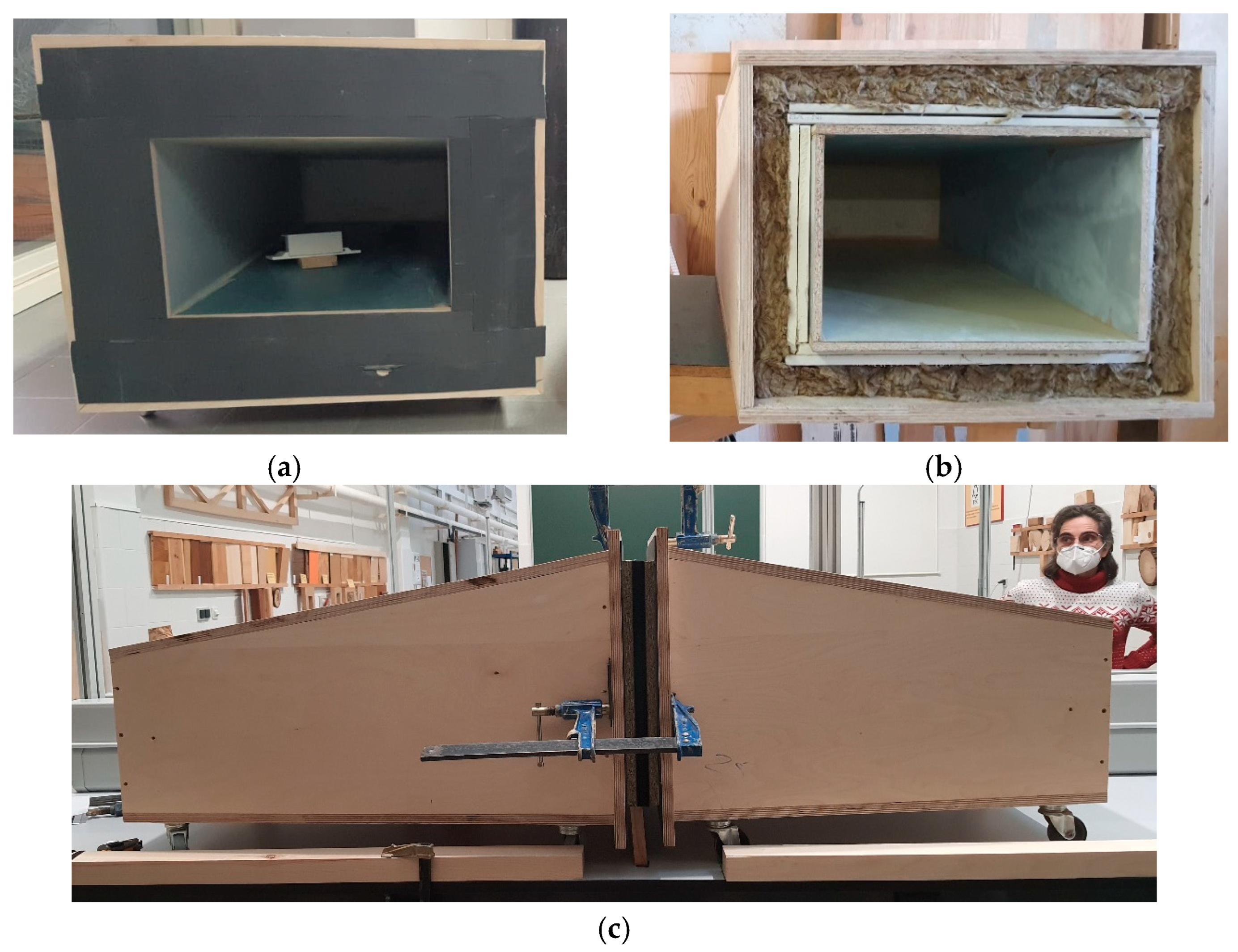
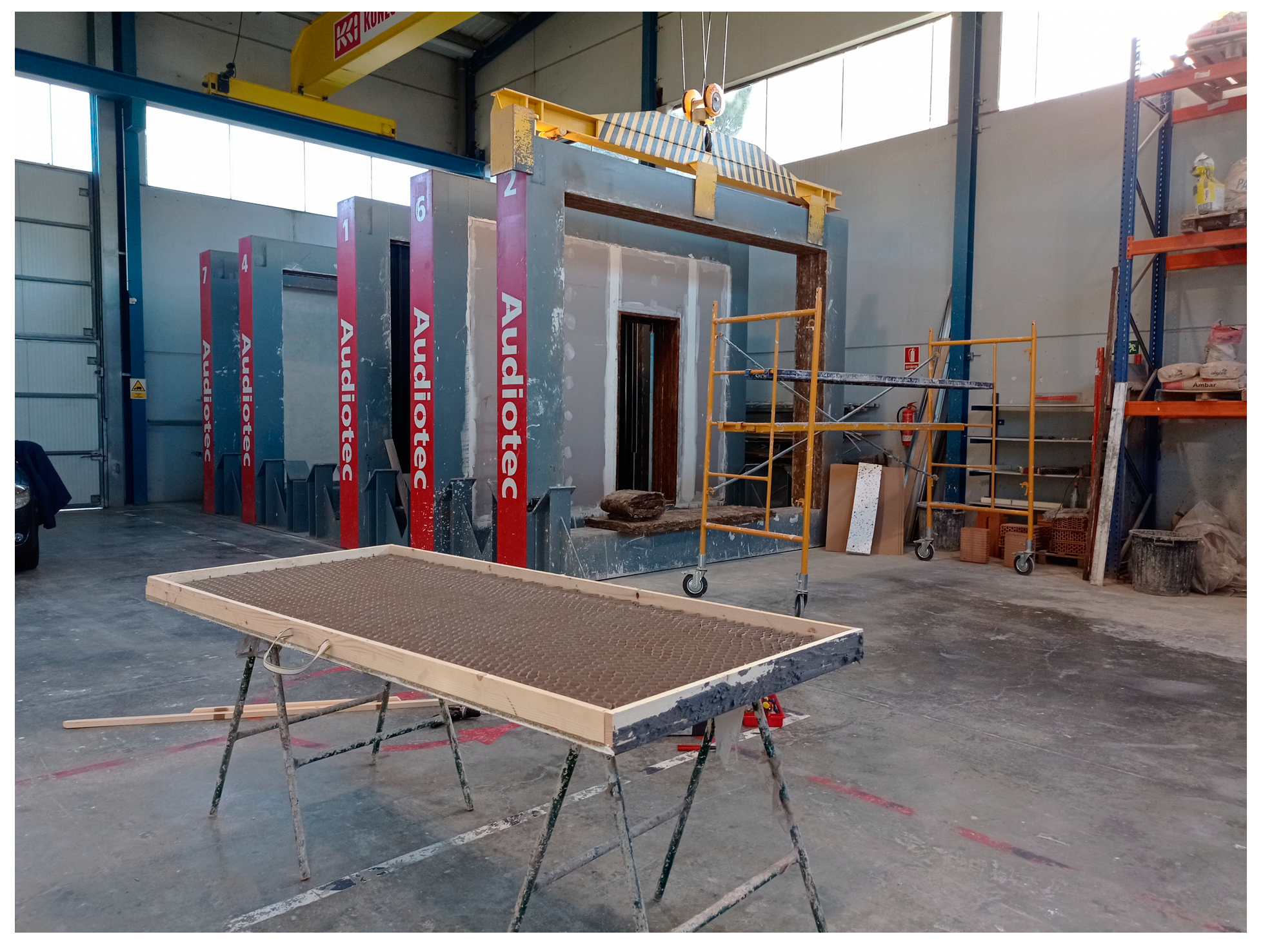
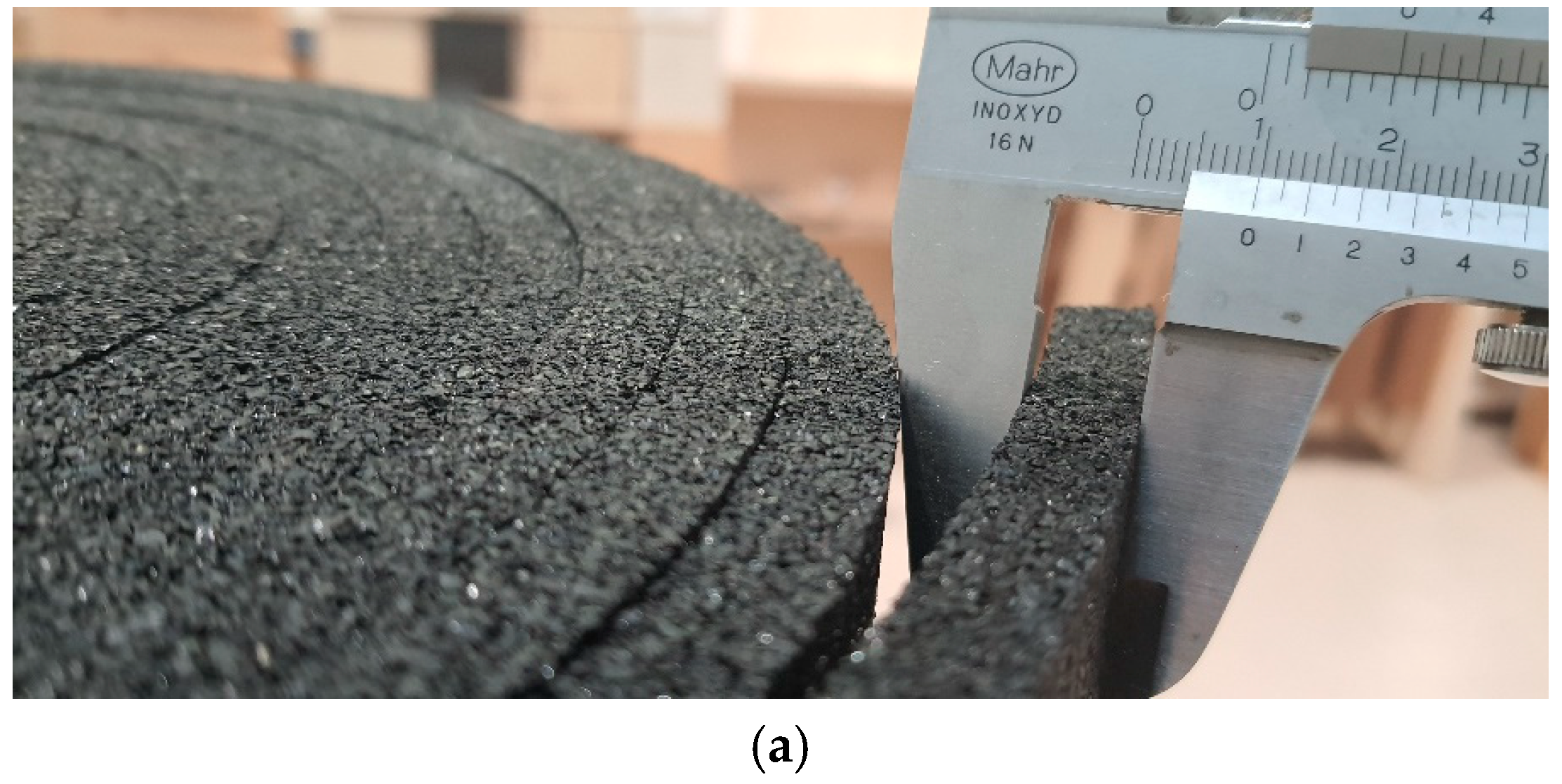
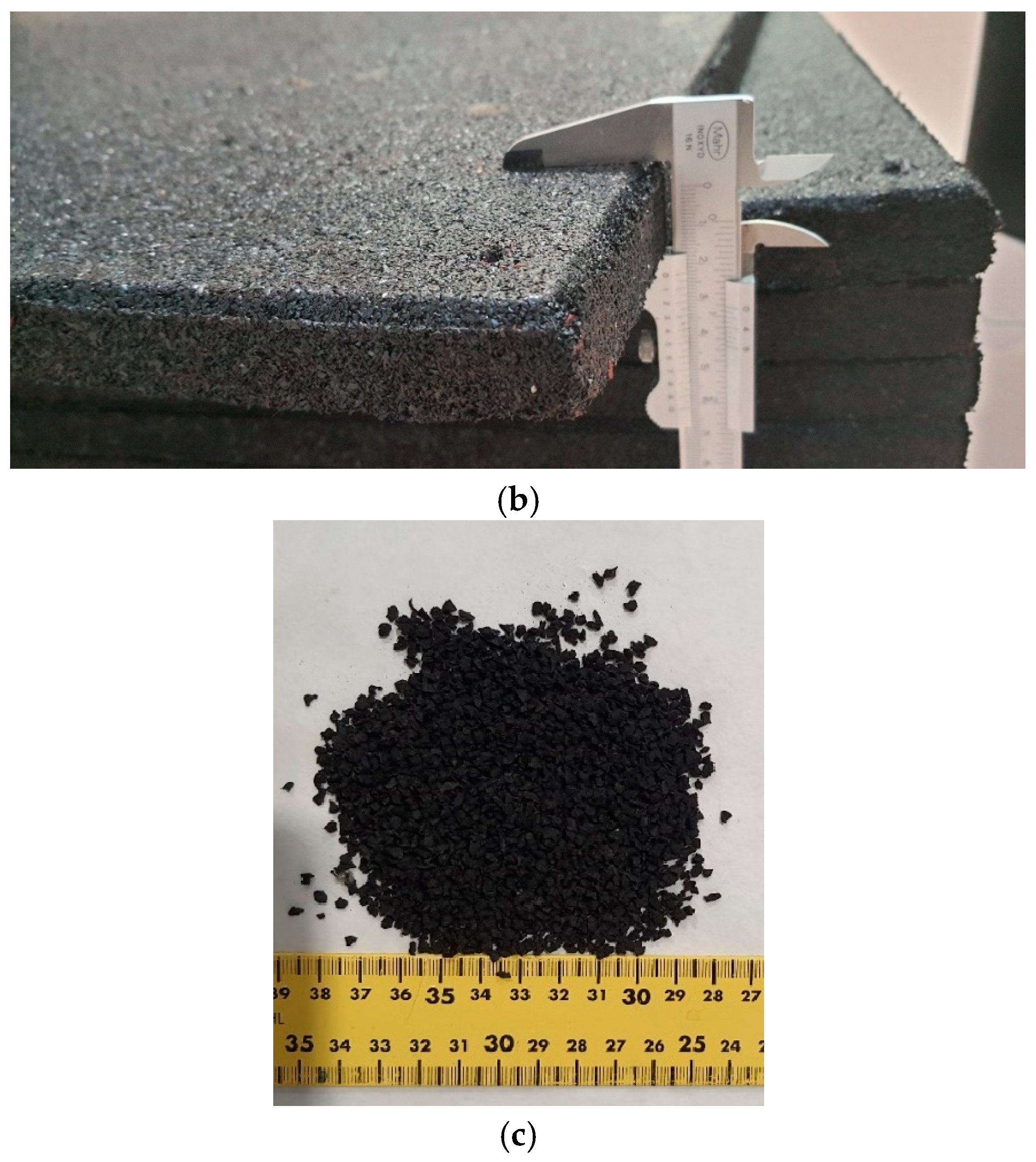
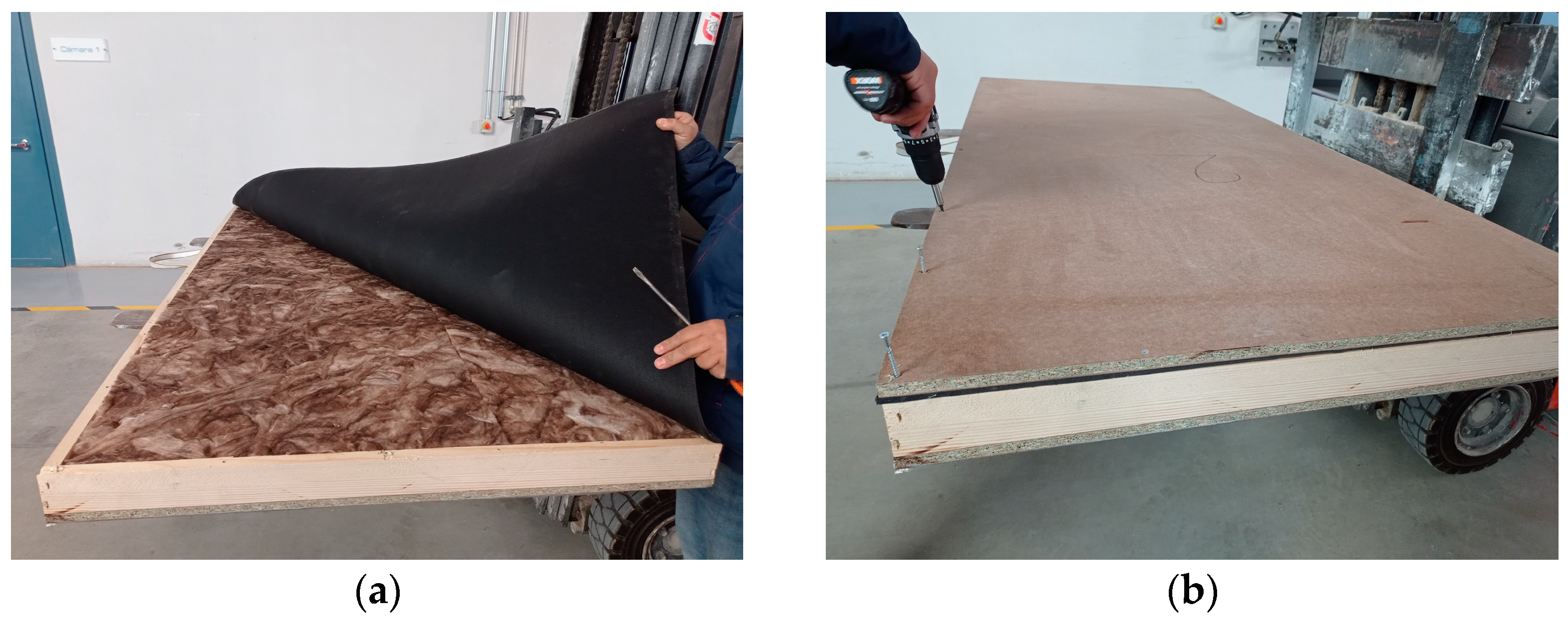
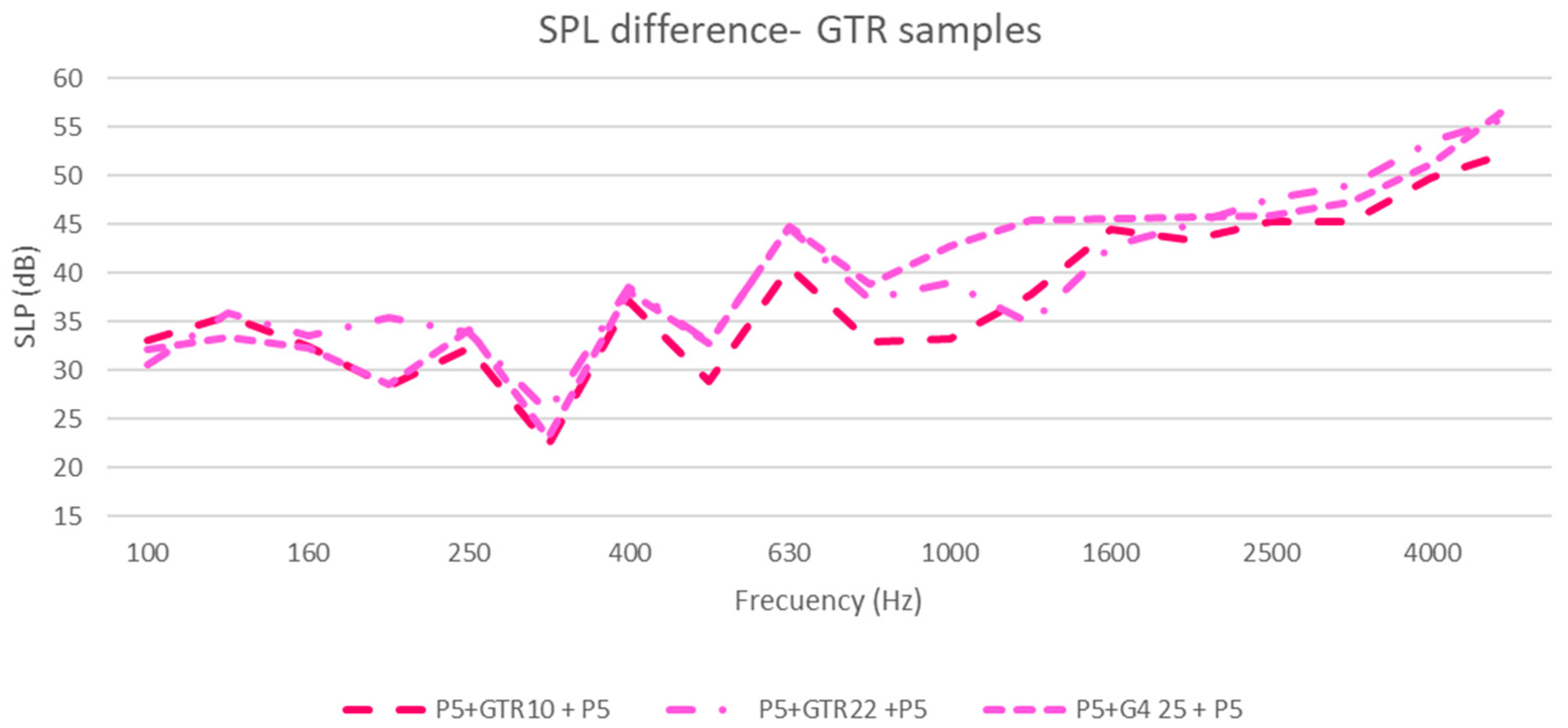

| Material | Density | Thermal Conductivity | Sound Abs. Coef. | References |
|---|---|---|---|---|
| (kg/m3) | (W/m·K) | (500 Hz) | ||
| Cellulose | 30–80 | 0.041–0.050 | 0.53–0.90 | [56,57] |
| Coconut fibres | 75–125 | 0.040–0.045 | 0.34–0.83 | [58,59,60] |
| Cork fibres | 110–170 | 0.039–0.050 | 0.39–0.85 | [61,62] |
| Flax fibres | 20–100 | 0.035–0.075 | 0.54–0.84 | [57] |
| Hemp fibres | 20–90 | 0.040–0.060 | 0.25–0.60 | [57,60] |
| Jute fibres | 35–100 | 0.038–0.055 | 0.20–0.56 | [59,63] |
| Kenaf fibres | 30–180 | 0.034–0.053 | 0.42–0.95 | [60,64,65] |
| Sheep wool | 10–25 | 0.034–0.054 | 0.36–0.90 | [60,66,67,68] |
| Straw bale | 50–150 | 0.053–0.065 | 0.70–0.78 | [69,70] |
| Wood fibres | 50–270 | 0.042–0.050 | 0.16–0.32 | [57,60,71] |
| Material | Density | Thermal Conductivity | Sound Abs. Coef. | References |
|---|---|---|---|---|
| (kg/m3) | (W/m·K) | (500 Hz) | ||
| Expanded Polystyrene (EPS) | 18–35 | 0.029–0.041 | 0.22–0.65 | [72] |
| Extruded Polystyrene (XPS) | 20–40 | 0.025–0.035 | 0.20–0.65 | [72,73] |
| Fibreglass wool | 13–100 | 0.030–0.045 | 0.45–0.80 | [72,74] |
| Perlite | 80–225 | 0.047–0.061 | 0.20–0.75 | [75,76,77] |
| Polyurethane (PUR) | 30–80 | 0.020–0.027 | 0.67–0.80 | [72] |
| Rock wool | 30–180 | 0.033–0.040 | 0.29–0.90 | [72,74,78] |
| Vermiculite | 80–200 | 0.047–0.070 | 0.50–0.80 | [77,79] |
| Material | Density | Thermal Conductivity | Sound Abs. Coef. | References |
|---|---|---|---|---|
| (kg/m3) | (W/m·K) | (500 Hz) | ||
| Recycled cotton fibres | 25–45 | 0.036–0.044 | 0.66–0.95 | [85] |
| Recycled fibreglass wool | 100–165 | 0.038–0.050 | - | [86] |
| Recycled polyethylene terephthalate (PET) | 15–60 | 0.034–0.039 | - | [87] |
| Recycled rubber | 500–930 | 0.100–0.140 | 0.20–0.80 | [88,89] |
| Recycled textile fibres | 200–500 | 0.041–0.053 | - | [90,91] |
| Product | Code | Thickness | Description |
|---|---|---|---|
| Roll | GTR6 | 6 ± 1 mm | GTR rubber roll of 1500 × 10.000 mm. Nominal density of 980 kg/m3 |
| Roll | GTR10 | 10 ± 1 mm | GTR rubber roll of 1500 × 10.000 mm. Nominal density of 780 kg/m3 |
| Sheet | GTR22 | 22 ± 1 mm | GTR rubber sheet of 500 × 500 mm. Nominal density of 900 kg/m3 |
| Granules | G4 | 2.5–4 mm | GTR rubber granules of 2.5–4 mm diameter. Apparent density of 600 kg/m3 |
| Product | Code | Thickness | Description |
|---|---|---|---|
| Structural particle board (class P5) | P5 | 16 ± 1 mm | Panel of 1200 × 2450 mm. Nominal density of 670 kg/m3 |
| Ultracoustic-R mineral wool | Ultracoustic-R60 | 60 ± 5 mm | Panel of 600 × 1350 mm. Nominal density of 30 kg/m3 |
| AISLAnat, cellulose-based material | Cellulose 60 | 60 ± 5 mm | Compacted product Nominal density of 65 kg/m3 |
| STEICO flex F308, wood fibre material | Wood fibre 112 | 110 ± 10 mm | Panel of 600 × 1220 mm. Nominal density of 50 kg/m3 |
| Specimen Code | Inside Composition | Layer Thickness (mm) | Total Thickness (mm) |
|---|---|---|---|
| S01 | P5 + GTR10 + P5 | 16 + 10 + 16 | 42 |
| S02 | P5 + GTR22 + P5 | 16 + 22 + 16 | 55 |
| S03 | P5 + G4 (25) + P5 | 16 + 25 + 16 | 57 |
| S04 * | P5 + Ultracoustic R60 + P5 | 16 + 60 + 16 | 92 |
| S05 | P5 + Ultracoustic R60 + GTR10 + P5 | 16 + 60 + 10 + 16 | 102 |
| S06 | P5 + Ultracoustic R60 + G4 (25) + P5 | 16 + 60 + 25 + 16 | 117 |
| S07 | P5 + cellulose 60 + P5 | 16 + 60 + 16 | 92 |
| S08 | P5 + cellulose 60 + GTR10 + P5 | 16 + 60 + 10 + 16 | 102 |
| S09 | P5 + cellulose 60 + G4(25) + P5 | 16 + 60 + 10 + 16 | 117 |
| S10 | P5 + wood fibre 112 + P5 | 16 + 112 + 16 | 144 |
| S11 | P5 + wood fibre 112 + GTR10 + P5 | 16 + 112 + 10 + 16 | 154 |
| S12 | P5 + wood fibre 112 + G4 (25) + P5 | 16 + 112 + 25 + 16 | 169 |
| Specimen Code | Inside Composition | Surface Mass (kg/m2) | Total Thickness (mm) |
|---|---|---|---|
| L1 = S04 | P5 + Ultracoustic R 60 + P5 | 23.6 | 92 |
| L2 | P5 + Ultracoustic R 60 + GTR6 + P5 | 29.9 | 98 |
| L3 = S05 | P5 + Ultracoustic R 60 + GTR10 + P5 | 31.4 | 102 |
| L4 = S06 | P5 + Ultracoustic R 60 + G4(25) + P5 | 34.4 | 117 |
| Frequency | S01 | S02 | S03 | S04 | S05 | S06 | S07 | S08 | S09 | S10 | S11 | S12 |
|---|---|---|---|---|---|---|---|---|---|---|---|---|
| 100 Hz | 33.05 | 30.55 | 32.23 | 38.72 | 37.47 | 42.32 | 41.55 | 44.07 | 39.91 | 31.43 | 33.25 | 39.15 |
| 125 Hz | 35.57 | 35.97 | 33.34 | 34.5 | 39.02 | 42.29 | 40.21 | 40.62 | 40.94 | 39.39 | 37.39 | 37.37 |
| 160 Hz | 32.51 | 33.63 | 32.31 | 31.86 | 35.10 | 34.58 | 34.32 | 36.04 | 29.93 | 35.59 | 31.04 | 29.34 |
| 200 Hz | 28.41 | 35.48 | 28.62 | 38.50 | 47.81 | 46.93 | 38.82 | 44.03 | 50.03 | 37.00 | 37.08 | 34.89 |
| 250 Hz | 32.29 | 33.94 | 34.18 | 19.54 | 29.95 | 26.22 | 24.12 | 35.84 | 42.39 | 34.25 | 23.87 | 33.88 |
| 315 Hz | 22.30 | 25.82 | 23.07 | 21.46 | 27.22 | 22.72 | 16.75 | 27.60 | 35.27 | 21.11 | 20.27 | 30.39 |
| 400 Hz | 37.09 | 38.49 | 38.03 | 32.44 | 38.19 | 36.60 | 39.17 | 46.01 | 45.29 | 38.70 | 40.67 | 48.95 |
| 500 Hz | 28.82 | 32.92 | 32.77 | 20.96 | 25.67 | 24.37 | 28.29 | 35.39 | 31.31 | 26.44 | 37.18 | 45.44 |
| 630 Hz | 40.64 | 44.64 | 44.79 | 32.23 | 38.38 | 36.97 | 39.83 | 47.09 | 42.07 | 40.61 | 50.15 | 56.34 |
| 800 Hz | 32.88 | 37.28 | 38.87 | 28.35 | 33.25 | 34.89 | 32.67 | 37.23 | 42.75 | 34.93 | 43.31 | 43.43 |
| 1 kHz | 33.26 | 39.03 | 42.82 | 31.46 | 35.37 | 30.96 | 39.64 | 40.04 | 39.66 | 38.59 | 41.37 | 48.13 |
| 1.25 kHz | 37.84 | 34.79 | 45.42 | 43.63 | 46.35 | 47.25 | 45.93 | 46.11 | 44.88 | 45.54 | 41.77 | 49.45 |
| 1.6 kHz | 44.48 | 42.80 | 45.55 | 38.65 | 44.14 | 43.17 | 43.21 | 45.56 | 41.10 | 50.75 | 39.08 | 46.22 |
| 2 kHz | 43.35 | 44.92 | 45.73 | 35.05 | 39.48 | 35.50 | 37.58 | 42.71 | 42.58 | 48.22 | 43.10 | 44.69 |
| 2.5 kHz | 45.22 | 47.56 | 45.84 | 38.31 | 46.36 | 40.35 | 39.80 | 47.09 | 44.71 | 50.10 | 40.40 | 50.85 |
| 3.15 kHz | 45.2 | 48.98 | 47.24 | 38.79 | 49.61 | 44.07 | 41.87 | 47.68 | 44.92 | 48.45 | 40.19 | 46.32 |
| 4 kHz | 49.73 | 53.56 | 51.22 | 40.83 | 53.71 | 45.79 | 43.19 | 52.13 | 47.91 | 52.74 | 43.98 | 51.48 |
| 5 kHz | 52.49 | 55.96 | 57.32 | 43.86 | 56.51 | 50.78 | 46.44 | 55.62 | 53.33 | 54.38 | 48.37 | 55.92 |
Disclaimer/Publisher’s Note: The statements, opinions and data contained in all publications are solely those of the individual author(s) and contributor(s) and not of MDPI and/or the editor(s). MDPI and/or the editor(s) disclaim responsibility for any injury to people or property resulting from any ideas, methods, instructions or products referred to in the content. |
© 2023 by the authors. Licensee MDPI, Basel, Switzerland. This article is an open access article distributed under the terms and conditions of the Creative Commons Attribution (CC BY) license (https://creativecommons.org/licenses/by/4.0/).
Share and Cite
Balmori, J.-A.; Casado-Sanz, M.; Machimbarrena, M.; Quirós-Alpera, S.; Mostaza, R.; Acuña, L. The Use of Waste Tyre Rubber Recycled Products in Lightweight Timber Frame Systems as Acoustic Insulation: A Comparative Analysis of Acoustic Performance. Buildings 2024, 14, 35. https://doi.org/10.3390/buildings14010035
Balmori J-A, Casado-Sanz M, Machimbarrena M, Quirós-Alpera S, Mostaza R, Acuña L. The Use of Waste Tyre Rubber Recycled Products in Lightweight Timber Frame Systems as Acoustic Insulation: A Comparative Analysis of Acoustic Performance. Buildings. 2024; 14(1):35. https://doi.org/10.3390/buildings14010035
Chicago/Turabian StyleBalmori, José-Antonio, Milagros Casado-Sanz, María Machimbarrena, Susana Quirós-Alpera, Roberto Mostaza, and Luis Acuña. 2024. "The Use of Waste Tyre Rubber Recycled Products in Lightweight Timber Frame Systems as Acoustic Insulation: A Comparative Analysis of Acoustic Performance" Buildings 14, no. 1: 35. https://doi.org/10.3390/buildings14010035
APA StyleBalmori, J.-A., Casado-Sanz, M., Machimbarrena, M., Quirós-Alpera, S., Mostaza, R., & Acuña, L. (2024). The Use of Waste Tyre Rubber Recycled Products in Lightweight Timber Frame Systems as Acoustic Insulation: A Comparative Analysis of Acoustic Performance. Buildings, 14(1), 35. https://doi.org/10.3390/buildings14010035






